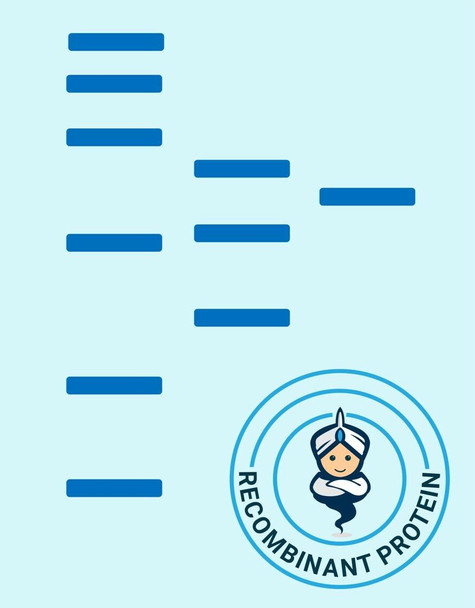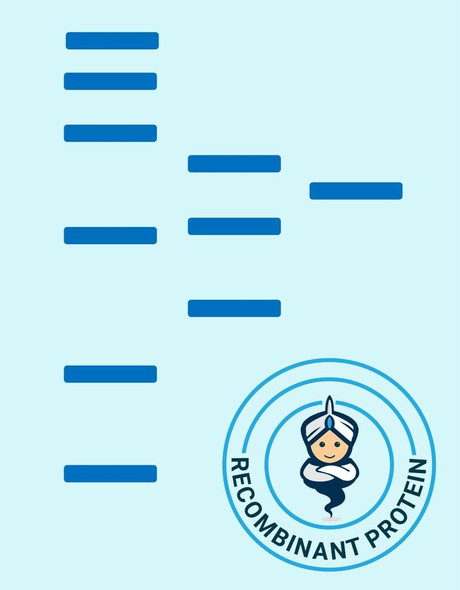Growth Factors & Cytokines Recombinant Proteins
Human SCF Recombinant Protein (RPPB0949)
- SKU:
- RPPB0949
- Product Type:
- Recombinant Protein
- Species:
- Human
- Uniprot:
- P21583
- Research Area:
- Growth Factors & Cytokines
Description
| Product Name: | Human SCF Recombinant Protein |
| Product Code: | RPPB0949 |
| Size: | 10µg |
| Species: | Human |
| Target: | SCF |
| Synonyms: | Kit ligand Precursor, C-kit ligand, SCF, Mast cell growth factor, MGF, SF, KL-1, Kitl, DKFZp686F2250. |
| Source: | Sf9 Insect cells |
| Physical Appearance: | Sterile Filtered White lyophilized (freeze-dried) powder. |
| Formulation: | The protein is supplied in 1xPBS, pH 7.4. |
| Solubility: | It is recommended to reconstitute the lyophilized Stem Cell Factor in 10mM acetic acid not less than 100�g/ml, which can then be further diluted to other aqueous solutions. |
| Stability: | Lyophilized KIT ligand although stable at room temperature for 3 weeks, should be stored desiccated below -18°C. Upon reconstitution SCF should be stored at 4°C between 2-7 days and for future use below -18°C. For long term storage it is recommended to add a carrier protein (0.1% HSA or BSA).Please prevent freeze-thaw cycles. |
| Purity: | Greater than 98.0% as determined by analysis by SDS-PAGE. |
| Biological Activity: | The ED50 as determined by the dose-dependent stimulation of Human TF-1 cells is typically 1-5 ng/ml. |
Stem cell factor / KIT ligand (SCF) is a cytokine which binds CD117(c-Kit). SCF is also known as "steel factor" or "c-kit ligand". SCF exists in two forms, cell surface bound SCF and soluble (or free) SCF. Soluble SCF is produced by the cleavage of surface bound SCF by metalloproteases.SCF is a growth factor important for the survival, proliferation, and differentiation of hematopoietic stem cells and other hematopoietic progenitor cells. One of its roles is to change the BFU-E (burst-forming unit-erythroid) cells, which are the earliest erythrocyte precursors in the erythrocytic series, into the CFU-E (colony-forming unit-erythroid).
Stem Cell Factor Human Recombinant produced in insect cells is a single, glycosylated polypeptide chain containing 165 amino acids and having a molecular mass of 18409 Dalton. The SCF is fused to a C-terminal His-tag (6xHis) and purified by proprietary chromatographic techniques.
| UniProt Protein Function: | SCF: Ligand for the receptor-type protein-tyrosine kinase KIT. Plays an essential role in the regulation of cell survival and proliferation, hematopoiesis, stem cell maintenance, gametogenesis, mast cell development, migration and function, and in melanogenesis. KITLG/SCF binding can activate several signaling pathways. Promotes phosphorylation of PIK3R1, the regulatory subunit of phosphatidylinositol 3-kinase, and subsequent activation of the kinase AKT1. KITLG/SCF and KIT also transmit signals via GRB2 and activation of RAS, RAF1 and the MAP kinases MAPK1/ERK2 and/or MAPK3/ERK1. KITLG/SCF and KIT promote activation of STAT family members STAT1, STAT3 and STAT5. KITLG/SCF and KIT promote activation of PLCG1, leading to the production of the cellular signaling molecules diacylglycerol and inositol 1,4,5- trisphosphate. KITLG/SCF acts synergistically with other cytokines, probably interleukins. Homodimer, non-covalently linked (Probable). Heterotetramer with KIT, binding two KIT molecules; thereby mediates KIT dimerization and subsequent activation by autophosphorylation. Belongs to the SCF family. 3 isoforms of the human protein are produced by alternative splicing. |
| UniProt Protein Details: | Protein type:Membrane protein, integral Chromosomal Location of Human Ortholog: 12q22 Cellular Component: extracellular space; cytoskeleton; cytoplasm; integral to membrane; extracellular region; plasma membrane Molecular Function:protein binding; growth factor activity; cytokine activity; stem cell factor receptor binding Biological Process: epidermal growth factor receptor signaling pathway; fibroblast growth factor receptor signaling pathway; phosphoinositide-mediated signaling; nerve growth factor receptor signaling pathway; embryonic hemopoiesis; male gonad development; germ cell programmed cell death; signal transduction; positive regulation of MAP kinase activity; cell proliferation; positive regulation of peptidyl-tyrosine phosphorylation; negative regulation of mast cell apoptosis; positive regulation of melanocyte differentiation; innate immune response; positive regulation of Ras protein signal transduction; positive regulation of myeloid leukocyte differentiation; cell adhesion; neural crest cell migration; positive regulation of DNA replication Disease: Hyperpigmentation, Familial Progressive, 2; Skin/hair/eye Pigmentation, Variation In, 7 |
| NCBI Summary: | This gene encodes the ligand of the tyrosine-kinase receptor encoded by the KIT locus. This ligand is a pleiotropic factor that acts in utero in germ cell and neural cell development, and hematopoiesis, all believed to reflect a role in cell migration. In adults, it functions pleiotropically, while mostly noted for its continued requirement in hematopoiesis. Two transcript variants encoding different isoforms have been found for this gene. [provided by RefSeq, Jul 2008] |
| UniProt Code: | P21583 |
| NCBI GenInfo Identifier: | 134289 |
| NCBI Gene ID: | 4254 |
| NCBI Accession: | P21583.1 |
| UniProt Secondary Accession: | P21583,Q16487, Q68DZ2, Q7M4N8, Q9UQK7, A0AV09, A8K2Q4 B7ZLM4, |
| UniProt Related Accession: | P21583 |
| Molecular Weight: | Approximately 150 kDa |
| NCBI Full Name: | Kit ligand |
| NCBI Synonym Full Names: | KIT ligand |
| NCBI Official Symbol: | KITLG�� |
| NCBI Official Synonym Symbols: | SF; MGF; SCF; FPH2; KL-1; Kitl; SHEP7�� |
| NCBI Protein Information: | kit ligand; c-Kit ligand; steel factor; stem cell factor; mast cell growth factor; familial progressive hyperpigmentation 2 |
| UniProt Protein Name: | Kit ligand |
| UniProt Synonym Protein Names: | Mast cell growth factor; MGF; Stem cell factor; SCF; c-Kit ligandCleaved into the following chain:Soluble KIT ligand; sKITLG |
| Protein Family: | SCF-associated factor |
| UniProt Gene Name: | KITLG�� |
| UniProt Entry Name: | SCF_HUMAN |






